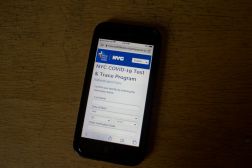Third-party apps proliferate inside national parks
Richard Ferdig was hiking through Cuyahoga Valley National Park in Ohio with his sons when an owl swooped overhead. His boys were hungry to learn more about what they just saw, but Ferdig found himself struggling to field their questions.
“Imagine the joy of basically being able to have a park ranger with you wherever you go,” Ferdig, an education technology expert at Kent State University, thought at the time.
Ferdig — with a team of park rangers, computer scientists and education experts — received a nearly $1 million grant over three years from the National Science Foundation to provide just that: an interactive Cuyahoga Valley National Park app meant to supplement the efforts of Cuyahoga’s park rangers.
When the Cuyahoga app launches, it will be one of hundreds of third-party apps of varying complexity, quality and functionality sprouting up to enhance the experience of those who traverse the national parks system. Tim Cash, the Park Service’s digital strategy chief, said engaging parks visitors on their smartphones and tablets is critical: Just shy of 50 percent of those who drop by NPS.gov do so on their mobile devices.
“Clearly, parks are looking to satisfy their visitors’ needs today and are working with third parties to develop apps,” he told FedScoop.
Not all the apps come from the parks themselves, though. The startup Chimani, which has produced apps for more than a dozen national parks, purposely does not establish formal relationships with the public lands it covers. Founder Kerry Gallivan, who started the company after he had a hard time pulling up trail information on his iPhone while hiking through Acadia National Park in Maine, said his background in international development made him wary of working directly with the government.
“I always knew how slow [government agencies] moved — and how quickly technology needed to move,” he said. “If I was going to do something that was really kind of innovative … I knew I really couldn’t do this if I were going to be beholden to a government entity.”
Though, he said he does work to keep the parks in the loop.
Indeed, working with partners can be a challenge.
Canyonlands Natural History Association, a nonprofit that supports the Canyonlands and Arches national parks, ran into trouble when it raised money and worked with a vendor to create an official app for the parks. Cindy Hardgrave, executive director of the association, said her group was not prepared for the “black hole of man-hours” necessary to create the app. And, once launched, it didn’t get the pick up the group had anticipated.
“Our hope was an ‘official app,’ vetted by the park, might gain more favor from app users,” she said via email. “That was not the case.”
Increasingly, though, the Park Service along with its parent agency, the Department of the Interior, have been looking for ways to engage technologists who want to use their data.
Earlier this month, Interior teamed up with the Department of Agriculture and held a hackathon to encourage computer whizzes to tap public lands data and create their own products and apps. The departments also released a new application programming interface, or API, that accesses data that could help the public plan for a visit on public lands.
Going forward, Interior and Agriculture will continue to work with technologists who want to use their data, Tim Fullerton, Interior’s director of new media, told FedScoop at the hackathon.
“At the end of the day, this is going to make the public’s experience on public lands better,” Fullerton said. “In fact, they might be able to find and experience different places that they didn’t even know existed.”
Park Service’s ‘standard framework’ for apps
In the long term, the Park Service is working on a kind of content management system that will allow individual parks to easily create and manage their own mobile apps, Cash said. Using a standard framework, each park could pop in data to provide visitors with orientation and activity planning information, and education content.
Several smaller parks — the Herbert Hoover National Historic Site in Iowa, Fort Smith National Historic Site in Arkansa and Klondike Gold Rush National Historical Park in Alaska — plan to unveil apps using this new system.
“It’s not very cost-effective for us to have every park design their own experience,” Cash said. He said the framework could be applied throughout the system, but each park could decide whether using the standard framework makes sense — or whether to pursue something independently.
Startup founder Gallivan said a key challenge for the Park Service as they work to develop an apps framework that would work for all its 407 parks might be to make sure it functions in areas where users might not have a signal. Indeed, that’s something Ferdig in Ohio is taking into account: His team is designing the app so users can download what they need on their device before setting off into the park.
As he creates the app, Ferdig said he wants to seize upon how children learn best about science. It’s an important issue for him — and the lawmakers and members of industry across the country who want to encourage more kids to pursue careers in science and technology. But Ferdig said part of getting children interested in science is recognizing where they can encounter science informally, outside of classrooms or museums.
“National parks are these incredible resources that have all these opportunities to learn things about science … but that doesn’t happen automatically,” he said.
Read more of FedScoop’s special report, “Focus on Mobility 2015.”






